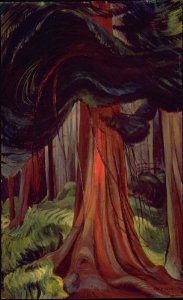 This image was painted during the time these journal entries were being originally written. These journals span the time from November 1927 to March 7, 1941.
This image was painted during the time these journal entries were being originally written. These journals span the time from November 1927 to March 7, 1941.
"Why call this manuscript Hundreds and Thousands? Because it is made up of scraps of nothing which, put together, made the trimming and furnished the sweetness for what might otherwise have been a drab life sucked away without crunch. Hundreds and Thousands are minute candies made in England--round sweetnesses, all colours and so small that separately they are not worth eating. But to eat them as we ate them in childhood was a different matter. Father would take the big fat bottle off his sample shelf in his office and say, 'Hold out your hands.' Father tipped and poured, and down bobbed our three hands and out came our three tongues and licked in the Hundreds and Thousands, and lapped them up, lovely and sweet and crunchy.
It was these tiny things that, collectively, taught me how to live. Too insignificant to have been considered individually, but like the Hundreds and Thousands lapped up and sticking to our moist tongues, the little scraps and nothingnesses of my life have made a definite pattern. Only now, when the river has nearly reached the sea and small eddies gush up into the river's mouth and repulse the sluggish onflow, have they made a pattern in the mud flats, before gurgling out into the sea. Thank you, tiny Hundreds and Thousands. Thanks, before you merge into the great waters."
--From a notebook found among Miss Carr's papers.
--Preface to Hundreds and Thousands.
The journal opens with Emily going to Toronto to meet with the Group of Seven for the first time. Her reaction to their work and they themselves is as follows:
"Thursday, November 17th
Oh, God, what have I seen? Where have I been? Something has spoken to the very soul of me, wonderful, mighty, not of this world. Chords way down in my being have been touched. Dumb notes have struck chords of wonderful tone. Something has called out of somewhere. Something in me is trying to answer.It is surging through my whole being, the wonder of it all, like a great river rushing on, dark and turbulent, and rushing and irresistible, carrying me away on its wild swirl like a helpless little bundle of wreckage. Where, where? Oh, these men, this Group of Seven, what have they created?--a world stripped of earthiness, shorn of fretting details, purged, purified; a naked soul, pure and unashamed; lovely space filled with wonderful serenity. What language do they speak, those silent, awe-filled spaces? I do not know. Wait and listen; you shall hear by and by. I long to hear and yet I'm half afraid. I think perhaps I shall find God here, the God I've longed and hunted for and failed to find. Always he's seemed nearer out in the big spaces, sometimes almost within reach but never quite. Perhaps in this newer, wider, space-filled vision I shall find him."
--Hundreds and Thousands, pp. 6-7
The Group member who had the most influence on Emily and her future work was Lawren Harris. Through their future correspondences Lawren would encourage Emily in her work, and in herself. It was Lawren Harris who suggested that she leave the Indian theme in her work and concentrate on the forests of B.C.
"Every letter he wrote stimulated me to search deeper. Lawren Harris made things worthwhile for their own sake. Artist...there is no realization, only momentum towards fulfillment, something indeed that we cannot attain individually, separately, only as the complete spiritual solidarity, mankind....Strive we must..."
--Growing Pains, p. 257
To read further about Emily and Lawren's correspondences, see the Lawren Harris chapter in Growing Pains.
- Return to books by Emily.
- Go to books about Emily.
- Go to articles about Emily.
- Purchase books.
- Writings main page.







